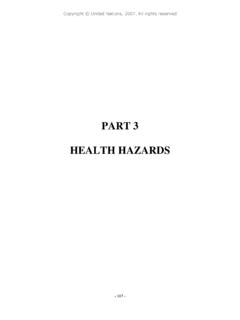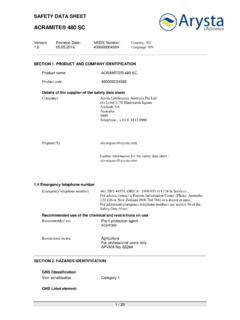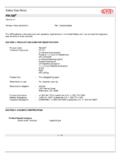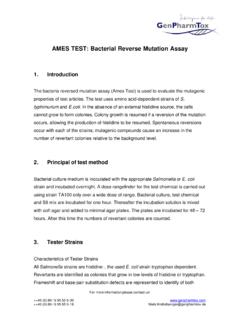Transcription of REACH - Minimisation of Animal Testing
1 REACH - Minimisation of Animal Testing This leaflet provides a brief summary of the opportunities that are available to registrants to minimise Animal Testing . What is REACH ? REACH (Registration, Evaluation, Authorisation and restriction of CHemicals) is the system for controlling chemicals in Europe. It became law in the UK on 1 June 2007. The European Chemicals Agency (ECHA) is the regulatory authority that manages the implementation of REACH . Minimisation of Animal Testing When considering how to fulfil the REACH information requirements, opportunities are available to registrants to minimise Animal Testing and reduce costs. Over 14,000 substances have been registered to date (June 2016) and more are expected when the final phase-in deadline arrives in June 2018.
2 For a single, high-tonnage substance, with no pre-existing data, and no attempt to minimise Animal Testing , registration and subsequent fulfilment of the information gaps could require over 5,000 animals (assuming little or no avian Testing ). The REACH Regulation provides opportunities to reduce costs and register effectively using fewer animals than predicted. Article 13(4) of REACH stipulates that toxicological and ecotoxicological tests shall be carried out in compliance with EU Directive 86/609/EEC on Animal protection. This Directive has been superseded by Directive 2010/63/EU, which provides basic requirements for the care and accommodation of laboratory animals, and stipulates that experiments shall be designed to reduce the duration and intensity of suffering to the Animal .
3 Furthermore, experiments on live animals shall not be performed if the results can be obtained by another scientifically satisfactory method. The Animals (Scientific Procedures) Act 1986 (as amended in 2012) transposes Directive 2010/63/EU into UK law, and provides the regulatory framework for controlling Animal Testing in the UK. Where possible, scientifically sound approaches to the implementation of the 3Rs (reduction, refinement or replacement of Animal use), which are already stipulated under the REACH Regulation, should be used. This is particularly important for the registration of the higher-tonnage substances, as it is very unlikely that complete replacements for some toxicity endpoints will be available. The Annexes in the REACH legislation (Annexes VII to XI) provide information and guidance on the adaption ( waiving ) of Animal tests.
4 ECHA has provided some further guidance to help; the most relevant is the REACH . 1. guidance on information requirements and Chemical Safety Assessment (CSA) . Key messages for registrants 1 Before concluding that there is an information gap for toxicity, the Substance Information Exchange Forum (SIEF) should consider all the available existing information. 2 Consider whether Animal Testing can be minimised by following one or more of the specific Testing adaptations provided in the REACH Regulation itself, see Part 1 (below). 3 If no specific adaptations are applicable, consider whether Animal Testing can be minimised in other more general ways in-lieu of Testing - see Part 2 (below). 4 If adaptation is not possible, and a new Animal test is required, ensure that the test of least severity and using the fewest animals is employed.
5 The test should be that expected to cause the least pain, suffering, distress and lasting harm. These are illustrated in the diagram overleaf: UK REACH Competent Authority Information Leaflet Number 18 Minimisation of Animal Testing July 2016. REACH - Minimisation of Animal Testing Can the information requirements Yes be met from existing data? No Can the information requirements be met using any Yes of the specified exemptions? Minimisation of Animal Testing and Animal welfare costs Annex VII to X. No Can the information requirements be met using any Yes of the general exemptions? Annex XI. No If Animal Testing is necessary, ensure that the test of least severity and that uses the minimum number of animals necessary (in line with scientific objectives) is employed.
6 The UK Competent Authority recommends that the duty holders who are compiling registration dossiers consider whether these approaches to the Minimisation of Animal Testing will be of relevance to them. Part 1: Opportunities for minimising new Animal Testing REACH Annexes VII-X. The standard REACH information requirements can be found in column 1 of the tables in Annexes VII to X. In column 2 there are rules for adaptation of the tests specified in column 1. These rules outline circumstances in which a particular information requirement involving a vertebrate- Animal test may be modified. There are many specific rules, and some of the key ones are detailed in Table 1, below. Most significantly, there are derogations for: postponement of reproductive toxicity (fertility) Testing , and circumstances for waiving of the short-term repeated dose and reproductive toxicity screening studies.
7 The validation status of alternative tests is subject to regular change, and those commissioning tests should take account of this by checking the current status. UK REACH Competent Authority Information Leaflet Number 18 Minimisation of Animal Testing July 2016. REACH - Minimisation of Animal Testing Table 1 Key opportunities for minimising new Animal Testing (Annex VII to X). Opportunities to adapt tests - Annex VII (1-10 tonnes/annum). Skin Sensitisation Non- Animal Testing will soon be the standard requirement. An amendment to Annex VII of REACH to reflect this change is expected in Autumn 2016. Draft guidance on the information requirements for this endpoint can be found on the 2. ECHA website . Where an in vivo test is required, the study of choice is the Local Lymph Node Assay (LLNA OECD TG 429), with justification needed for guinea pig tests.
8 It is possible to use the reduced LLNA protocol as described in TG 429, but this does not give information on potency. Similarly, the two non-radiolabelled variants of the LLNA (OECD TGs 442A/B) do not currently provide information that could inform on potency. Acute Oral Toxicity The test does not need to be conducted if the substance is corrosive, or if an acute inhalation toxicity study is available. Weight of evidence (WoE) assessment (as described in Annex XI): The in vitro NRU3T3 test investigates toxicity via the oral route. This information can be used as part of a WoE assessment to waive the requirement for an acute oral toxicity study or inform on the appropriate dose. It may be possible to use information from existing repeated dose studies to inform on the acute toxicity of the substance.
9 Recent analysis showed that, in most cases, substances found to be of low toxicity in oral sub-acute studies of at least 28 days duration (NOAEL 1000mg/kg bw). are predicted to be not classified for acute oral toxicity ( LD50 >. 2000mg/kg bw). Therefore, if a repeated dose study gave a NOAEL . 1000mg/kg bw, it may be possible to include this, as part of a WoE. assessment, to waive the requirement for an acute oral toxicity test. Skin sensitisation Annex III provides the opportunity for some substances to be registered at 1-10. and Acute Oral tonnes per annum with a reduced set of information requirements. For further Toxicity details see our leaflet on Annex III. Opportunities to adapt tests - Annex VIII (10-100 tonnes/annum). Acute Dermal In addition to the Annex VII requirement for Acute Oral Toxicity Testing , Annex VIII.
10 Toxicity requires that the acute toxicity of the substance is tested via a second route of exposure (dermal or inhalation). The route chosen is dependent on the nature of the substance and the likely route of human exposure. For substances that are non-toxic via the oral route, the dermal test may be waived since these substances can be expected, with a high degree of certainty, to be non-toxic following dermal exposure. Skin irritation The Organisation for Economic Cooperation and Development (OECD) has agreed on test guidelines for alternative methods, which have been included in the Test Methods Regulation (440/2008/EEC). Annex VIII has been updated to reflect these advances; with the standard information requirement now being for the in vitro studies.

















